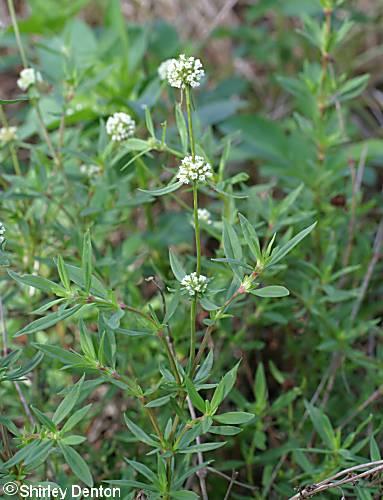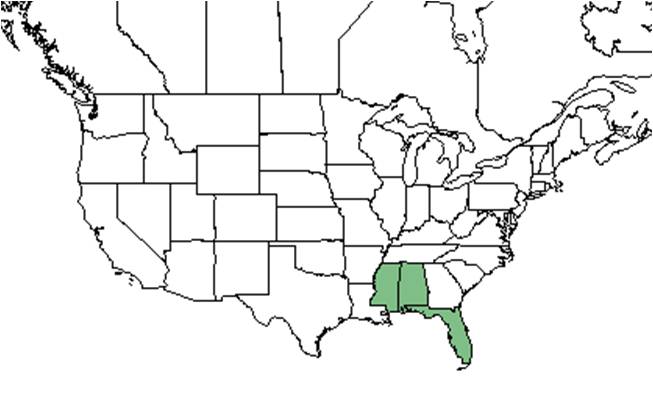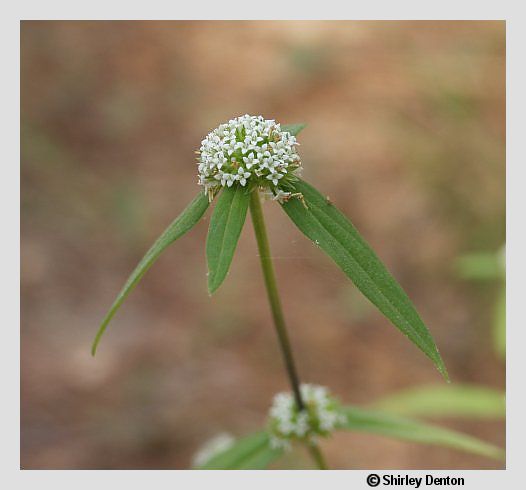Difference between revisions of "Spermacoce prostrata"
(→Description) |
HaleighJoM (talk | contribs) (→Ecology) |
||
| (28 intermediate revisions by 8 users not shown) | |||
| Line 3: | Line 3: | ||
{{taxobox | {{taxobox | ||
| name = Spermacoce prostrata | | name = Spermacoce prostrata | ||
| − | | image = | + | | image = Sper_pros.jpg |
| − | | image_caption = | + | | image_caption = Photo by Shirley Denton (Copyrighted, use by photographer’s permission only), [http://www.shirleydenton.com/welcome Nature Photography by Shirley Denton] |
| regnum = Plantae | | regnum = Plantae | ||
| divisio = Magnoliophyta - Flowering plants | | divisio = Magnoliophyta - Flowering plants | ||
| Line 15: | Line 15: | ||
| binomial_authority = Aubl. | | binomial_authority = Aubl. | ||
| range_map = sper_pros_dist.jpg | | range_map = sper_pros_dist.jpg | ||
| − | | range_map_caption = Natural range of ''Spermacoce prostrata'' from USDA NRCS [http:// | + | | range_map_caption = Natural range of ''Spermacoce prostrata'' from USDA NRCS [http://plants.usda.gov/core/profile?symbol=SPPR4 Plants Database]. |
}} | }} | ||
| + | |||
| + | Common name: Prostrate false buttonweed | ||
| + | ==Taxonomic notes== | ||
| + | Synonyms: ''Borreria ocymoides'' auct. non (Burm. f.) DC.; ''Spermacoce ocymoides'' auct. non Burm. f.; ''Spermacoce repens'' auct. non (DC.) Sessé & Moc., from USDA NRCS [http://plants.usda.gov/core/profile?symbol=SPPR4 Plants Database]. | ||
==Description== | ==Description== | ||
<!-- Basic life history facts such as annual/perrenial, monoecious/dioecious, root morphology, seed type, etc. --> | <!-- Basic life history facts such as annual/perrenial, monoecious/dioecious, root morphology, seed type, etc. --> | ||
| − | + | Prostrate or decumbent annual herbs to 40 cm tall, branching mostly near the bases, leafy stems 0.4-2 mm thick, glabrous or rarely with thin hairs to 0.8 mm long, with 4 longitudinal ribs 0.1-0.3 mm high; stipule sheaths 1-3 mm high, 1.5-6 mm broad, with 3-9 awns 1-2 mm long. Leaves opposite or pseudoverticillate with 2-4 smaller axillary leaves at each node, sessile or subsessile; leaf blades 10-35 mm long, 2-18 mm broad, elliptic to narrowly elliptic or elliptic-lanceolate, apex acute (obtuse), base cuneate and decurrent on petiole, drying membranaceous to chartaceous, greenish or yellowish brown, glabrous or with minute (0.2 mm) stiff hairs above and below, scabrous on the margin, 2º veins 2-4/side. Inflorescences mostly axillary (sometimes terminal), 2-4 mm high and 3-8 mm broad, flowers few (3-8) to many (ca. 20) and sessile. Flowers with hypanthium 0.5-1 mm long, calyx lobes usually 2 larger and 2 smaller, 0.6-1 mm long; corolla white, less than 3 mm long. Fruits ca. 2 mm long, body of the fruit 0.8-1.2 mm long; seeds 0.7-1.2 mm long, 0.3-0.5 mm broad, reticulate, often with longitudinal ridges (x 10) and distinctive transversely elongated pits (x40), dark reddish brown.<ref name="berger">Berger, W., ed. 1993. Flora Costaricensis. Fieldiana Botany New Series, No. 33: Family #202 Rubiaceae.</ref> | |
==Distribution== | ==Distribution== | ||
| + | It is found in Florida, Alabama and Mississippi. Outside of the United States it is found in the west Indies and South America.<ref name="saint">[[http://www.saintlucianplants.com/floweringplants/rubiaceae/sperpros/sperpros.html]]Saint Lucian Plants. Accessed: March 17, 2016</ref> | ||
| + | |||
==Ecology== | ==Ecology== | ||
===Habitat=== <!--Natural communities, human disturbed habitats, topography, hydrology, soils, light, fire regime requirements for removal of competition, etc.--> | ===Habitat=== <!--Natural communities, human disturbed habitats, topography, hydrology, soils, light, fire regime requirements for removal of competition, etc.--> | ||
| + | In the Coastal Plain in Florida, ''S. prostrata'' occurs in river floodplain forests, longleaf pine woods and powerline corridors. It has been observed growing in loamy sand.<ref name="fsu">Florida State University Robert K. Godfrey Herbarium database. URL: http://herbarium.bio.fsu.edu. Last accessed: November 2015. Collectors: Loran C. Anderson, Robert K. Godfrey. States and Counties: Florida: Calhoun, Franklin, Liberty, Wakulla. Compiled by Tall Timbers Research Station and Land Conservancy.</ref> | ||
| + | |||
===Phenology=== <!--Timing off flowering, fruiting, seed dispersal, and environmental triggers. Cite PanFlora website if appropriate: http://www.gilnelson.com/PanFlora/ --> | ===Phenology=== <!--Timing off flowering, fruiting, seed dispersal, and environmental triggers. Cite PanFlora website if appropriate: http://www.gilnelson.com/PanFlora/ --> | ||
| − | ===Seed dispersal=== | + | Flowers and fruits in October.<ref name="fsu"/> |
| − | ===Seed bank and germination=== | + | <!--===Seed dispersal===--> |
| − | ===Fire ecology=== <!--Fire tolerance, fire dependence, adaptive fire responses--> | + | <!--===Seed bank and germination===--> |
| + | <!--===Fire ecology===--> <!--Fire tolerance, fire dependence, adaptive fire responses--> | ||
===Pollination=== | ===Pollination=== | ||
| − | + | ''Spermacoce prostrata'' has been observed at the Archbold Biological Station to host sweat bees such as ''Lasioglossum lepidii'' (family Halictidae), thread-waisted wasps such as ''Anacrabro ocellatus'' and ''Cerceris blakei'', and wasps from the Vespidae family such as ''Leptochilus alcolhuus, Pachodynerus erynnis, P. nasidens, Parancistrocerus salcularis rufulus'' and ''Stenodynerus fundatiformis''.<ref name="Deyrup 2015">Deyrup, M.A. and N.D. 2015. Database of observations of Hymenoptera visitations to flowers of plants on Archbold Biological Station, Florida, USA.</ref> | |
| + | <!--===Herbivory and toxicology===<!--Common herbivores, granivory, insect hosting, poisonous chemicals, allelopathy, etc--> | ||
| + | <!--===Diseases and parasites===--> | ||
| − | + | ==Conservation, cultivation, and restoration== | |
| − | + | ==Cultural use== | |
| − | + | ==Photo Gallery== | |
| − | + | <gallery widths=180px> | |
| − | + | File: Sper_pros-SDenton_NatPhoto-Flwrs_fl71.jpg | <center> Flowers of ''Spermacoce'' ''prostrata'' <p> Photo by Shirley Denton (Copyrighted, use by photographer’s permission only), [http://www.shirleydenton.com/welcome Nature Photography by Shirley Denton] </p> | |
| − | + | </gallery> | |
| − | |||
| − | |||
| − | |||
| − | |||
| − | |||
| − | |||
| − | |||
| − | |||
| − | |||
| − | |||
| − | |||
| − | |||
==References and notes== | ==References and notes== | ||
Latest revision as of 17:56, 15 July 2022
| Spermacoce prostrata | |
|---|---|

| |
| Photo by Shirley Denton (Copyrighted, use by photographer’s permission only), Nature Photography by Shirley Denton | |
| Scientific classification | |
| Kingdom: | Plantae |
| Division: | Magnoliophyta - Flowering plants |
| Class: | Magnoliopsida – Dicotyledons |
| Order: | Rubiales |
| Family: | Rubiaceae |
| Genus: | Spermacoce |
| Species: | S. prostrata |
| Binomial name | |
| Spermacoce prostrata Aubl. | |

| |
| Natural range of Spermacoce prostrata from USDA NRCS Plants Database. | |
Common name: Prostrate false buttonweed
Contents
Taxonomic notes
Synonyms: Borreria ocymoides auct. non (Burm. f.) DC.; Spermacoce ocymoides auct. non Burm. f.; Spermacoce repens auct. non (DC.) Sessé & Moc., from USDA NRCS Plants Database.
Description
Prostrate or decumbent annual herbs to 40 cm tall, branching mostly near the bases, leafy stems 0.4-2 mm thick, glabrous or rarely with thin hairs to 0.8 mm long, with 4 longitudinal ribs 0.1-0.3 mm high; stipule sheaths 1-3 mm high, 1.5-6 mm broad, with 3-9 awns 1-2 mm long. Leaves opposite or pseudoverticillate with 2-4 smaller axillary leaves at each node, sessile or subsessile; leaf blades 10-35 mm long, 2-18 mm broad, elliptic to narrowly elliptic or elliptic-lanceolate, apex acute (obtuse), base cuneate and decurrent on petiole, drying membranaceous to chartaceous, greenish or yellowish brown, glabrous or with minute (0.2 mm) stiff hairs above and below, scabrous on the margin, 2º veins 2-4/side. Inflorescences mostly axillary (sometimes terminal), 2-4 mm high and 3-8 mm broad, flowers few (3-8) to many (ca. 20) and sessile. Flowers with hypanthium 0.5-1 mm long, calyx lobes usually 2 larger and 2 smaller, 0.6-1 mm long; corolla white, less than 3 mm long. Fruits ca. 2 mm long, body of the fruit 0.8-1.2 mm long; seeds 0.7-1.2 mm long, 0.3-0.5 mm broad, reticulate, often with longitudinal ridges (x 10) and distinctive transversely elongated pits (x40), dark reddish brown.[1]
Distribution
It is found in Florida, Alabama and Mississippi. Outside of the United States it is found in the west Indies and South America.[2]
Ecology
Habitat
In the Coastal Plain in Florida, S. prostrata occurs in river floodplain forests, longleaf pine woods and powerline corridors. It has been observed growing in loamy sand.[3]
Phenology
Flowers and fruits in October.[3]
Pollination
Spermacoce prostrata has been observed at the Archbold Biological Station to host sweat bees such as Lasioglossum lepidii (family Halictidae), thread-waisted wasps such as Anacrabro ocellatus and Cerceris blakei, and wasps from the Vespidae family such as Leptochilus alcolhuus, Pachodynerus erynnis, P. nasidens, Parancistrocerus salcularis rufulus and Stenodynerus fundatiformis.[4]
Conservation, cultivation, and restoration
Cultural use
Photo Gallery
Flowers of Spermacoce prostrata Photo by Shirley Denton (Copyrighted, use by photographer’s permission only), Nature Photography by Shirley Denton
References and notes
- ↑ Berger, W., ed. 1993. Flora Costaricensis. Fieldiana Botany New Series, No. 33: Family #202 Rubiaceae.
- ↑ [[1]]Saint Lucian Plants. Accessed: March 17, 2016
- ↑ 3.0 3.1 Florida State University Robert K. Godfrey Herbarium database. URL: http://herbarium.bio.fsu.edu. Last accessed: November 2015. Collectors: Loran C. Anderson, Robert K. Godfrey. States and Counties: Florida: Calhoun, Franklin, Liberty, Wakulla. Compiled by Tall Timbers Research Station and Land Conservancy.
- ↑ Deyrup, M.A. and N.D. 2015. Database of observations of Hymenoptera visitations to flowers of plants on Archbold Biological Station, Florida, USA.
